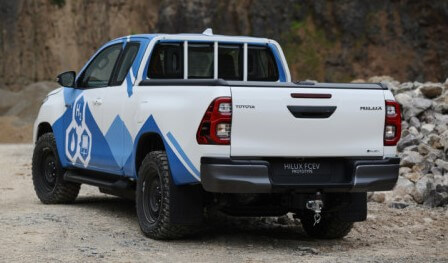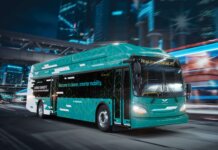Ten fuel cell Hilux pickup truck prototypes have now been built at the Toyota Motor Manufacturing UK (TMUK) facility in Derby, England. Five vehicles are undergoing field testing to assess safety, performance, functionality and durability, generating test drive data in real-world situations. Five further units are engaged in demonstrations, including two at the upcoming Olympic and Paralympic Games Paris 2024.
By engaging customers with hydrogen fuel cell technology, Toyota is laying the groundwork for a successful hydrogen transport sector in the future.
Since the unveiling of the first prototype vehicle in September 2023, Toyota and its consortium partners, supported by United Kingdom government funding, have reached an intensive evaluation and demonstration stage.
Toyota’s multi-path strategy toward carbon neutrality includes applying different powertrain solutions — hybrid electric, plug-in hybrid electric, battery electric, fuel cell electric and e-fuels — to suit different user needs and local infrastructure.
The company expects Europe to be one of the largest hydrogen fuel cell markets by 2030, with steady growth in mobility and power generation applications. As a result, in December 2023 Toyota Motor Europe (TME) announced the Hydrogen Factory Europe, representing Toyota’s coordinated approach to the commercialization of this technology.
Based on the original Toyota Hilux, with its reputation for Quality, Durability and Reliability (QDR) on the world’s toughest terrain, the hydrogen fuel cell prototype Hilux showcases how fuel cell technology can be integrated into a pickup.
Externally, the fuel cell Hilux retains the same dimensions and rugged appearance as the original Hilux. In extra-cab format, it is 5,325 mm long, 1,855 mm wide and 1,810 mm high, but beneath the surface, Toyota’s fuel cell technology sets the vehicle apart.
Power is delivered using core elements from the Toyota Mirai. This technology has proved its quality in commercial production since Toyota introduced the world’s first mass-produced hydrogen fuel cell sedan in 2015.
The fuel cell Hilux has an expected driving range of up to 600 km. Meanwhile, because of hydrogen’s light weight, a higher payload and towing capability can be achieved versus other zero-emission alternatives.
Hydrogen is stored in three high-pressure fuel tanks, each containing 2.6 kg for a total system capacity of 7.8 kg. Tanks are mounted within the ladder frame chassis.
The polymer electrolyte fuel cell stack contains 330 cells and is mounted above the front axle. The fuel cell Hilux is rear-wheel drive via an e-motor on the rear axle, which delivers 134 kW of maximum power and 300 Nm maximum torque. When driving, the fuel cell produces no tailpipe emissions, only pure water.
A lithium-ion hybrid battery, which stores the electricity produced on board by the fuel cell, is positioned in the rear load deck, above the hydrogen tanks. This avoids any loss of cabin space.






